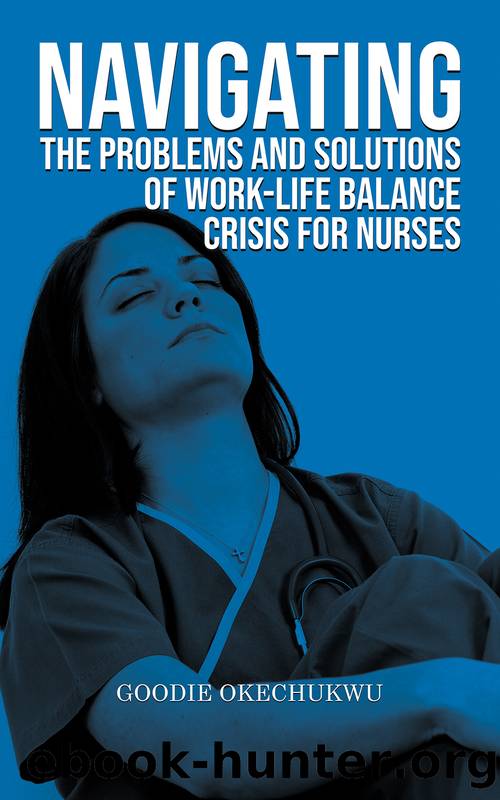Navigating the Problems and Solutions of Work-Life Balance Crisis for Nurses by Okechukwu Goodie;

Author:Okechukwu, Goodie;
Language: eng
Format: epub
Publisher: Austin Macauley Publishers
Published: 2020-03-02T00:00:00+00:00
An inability to reorganise work amongst existing staff (BIS 2010; ACAS 2017)
An inability to recruit additional staff (BIS 2010; ACAS 2017)
A detrimental impact on quality (BIS 2010; ACAS 2017)
A detrimental impact on performance (BIS 2010; ACAS 2017)
Detrimental effect on ability to meet customer demand (BIS 2010; ACAS 2017)
Insufficient work for the periods the employee proposes to work (BIS 2010; ACAS 2017)
A planned structural change to your business. (BIS 2010; ACAS 2017)
This suggest that nurses may face an uphill task in gaining flexible working arrangements due to little or no room for manoeuvring in the Flexible Working Regulations (ACAS 2017). This presents a major risk given that evidence indicate persistent nursing staff shortage (NMC 2017), NHS cuts, tight budgets and limited funding hence nurses are having to depend more on the goodwill and support of their managers to gain suitable working arrangements and achieve a WLB. Indeed, flexible working arrangements for nurses has been criticised for its managerialist approach and its emphasis on preserving existing constructs of work (Fleetwood 2007; Wheatley 2016), and there are concerns that the clause âdue considerationâ is not clearly defined and may be subject to individual managerâs interpretation (ACAS 2017).
Another critical issue is that employers pay less attention to the gendered nature of flexible work arrangement. Evidence suggests that flexible working arrangement for employees remains gendered (Fleet 2007; Teasdale 2013; Wheatley 2016). Although flexible working arrangements has the potential to provide greater degree of work control for employees, the drivers and patterns of flexible working arrangement vary considerably and this can be influenced by gender (Van Wanroy et al. 2011). Men can use flexible working arrangements more out of choice and this enables them to retain full-time hours and its associated benefits (Sullivan and Smithson 2007). Whereas for women the use of flexible working arrangements out of constraints rather than choice due to caring commitments and they maybe detrimentally affected with lower career options (Atkinson and Hall 2009; McIntosh et al. 2015).
Postmodern feminists would suggest that âcome to their ownâ, in terms of acquiring more education, gaining better employment, advancing in leadership roles and contributing financially to the family (Thomson 2007; Schultz 2010; Chaney 2015, Fairchild 2015; Lundberg 2015).
However, women still shoulder the overwhelming burden of unpaid household tasks, particularly if it is coupled with caring responsibilities (Fleet 2007; Schultz 2010; Ergeneli et al. 2010; Chaney 2015). Postmodern feminism has done nothing to alleviate the burden of the number of unpaid hours of work that women should bear but quite contrarily factors like increased life expectancy means that women are taking on more responsibilities in caring for an elderly member of the family (Thomson 2007; Chaney 2015; Fairchild 2015; Lundberg 2015). Women in these circumstances try to maintain continued employment by working part-time (Green and Livanos 2015).
However, conflict between work and life as experienced by women is influenced by variables such as the size of family, the age of children, the work hours, social status, finance and the level of social support. The problem is that
Download
This site does not store any files on its server. We only index and link to content provided by other sites. Please contact the content providers to delete copyright contents if any and email us, we'll remove relevant links or contents immediately.
The Art of Coaching Workbook by Elena Aguilar(51002)
Trainspotting by Irvine Welsh(21522)
The Secret History by Donna Tartt(18860)
Twilight of the Idols With the Antichrist and Ecce Homo by Friedrich Nietzsche(18510)
All the Missing Girls by Megan Miranda(15597)
Cat's cradle by Kurt Vonnegut(15190)
Ready Player One by Cline Ernest(14533)
Talking to Strangers by Malcolm Gladwell(13233)
Fangirl by Rainbow Rowell(9108)
The remains of the day by Kazuo Ishiguro(8832)
The Compound Effect by Darren Hardy(8821)
Thirteen Reasons Why by Jay Asher(8800)
Tools of Titans by Timothy Ferriss(8225)
Periodization Training for Sports by Tudor Bompa(8174)
Wonder by R. J. Palacio(8014)
The Lover by Duras Marguerite(7834)
A Court of Wings and Ruin by Sarah J. Maas(7654)
Change Your Questions, Change Your Life by Marilee Adams(7640)
The Complete Stick Figure Physics Tutorials by Allen Sarah(7312)
